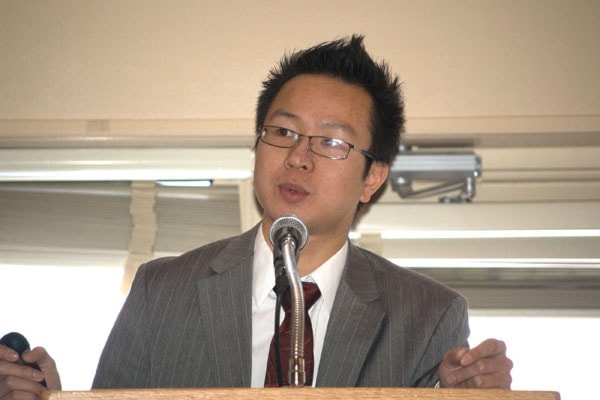Although news reports are filled with the economic turmoil in Europe, that doom and gloom isn’t expected to have strong impacts in Canada or, more specifically, in the Shuswap.
Bryan Yu, economist with the Central 1 Credit Union, the umbrella organization for the credit union system in B.C. and Ontario, presented this and other parts of his economic analysis on Nov. 16 to the Salmon Arm Economic Development Society’s Second Annual Business Forum.
Yu said Canada remains in a strong position globally, with its debt relatively low. Events in Europe and the U.S. will impact Canada through declines in commodity prices such as metals and energy, he said. As prices lower they may put downward pressure on the Canadian dollar, but he’s not expecting to see much movement away from parity with the U.S.
“We won’t be seeing a 60-cent dollar anytime soon, or an 80 cent dollar.”
Inflation has risen slightly in the last couple of quarters, but “I expect to see inflation actually come down a little.”
Yu predicts minimal pressure on interest rates, so there will be a “flat environment for interest rates through 2013.”
B.C. is expected to follow broader economic trends, with muted growth of about two per cent in 2012.
Employment growth will also remain low.
“Almost all growth is in Metro Vancouver,” he said. “Here in the Thompson Okanagan regions, there have been flat employment levels since 2007, with some dips and increases.”
He said people in the region have been leaving the labour force, either by leaving the area or pulling out of the job market.
No employment rates were available to him for the Columbia Shuswap, but he said employment insurance numbers are “relatively elevated” but falling. “They’re going in the right direction; that’s slightly positive.”
What’s more positive, he said, is that business formation in the Columbia Shuswap this year is outpacing that in 2010.
Forestry, tourism and demographics are the main drivers in the local economy, he said.
Sawmill production will see an upward trend, he predicted, as the forestry sector sells more to China and the demand increases there.
“Over time, it’s a very positive picture. I expect to see continued demand for wood products.”
Also, as rental rates rise in the U.S., he said, more people will consider home ownership, which will increase demand over time for B.C. lumber.
Trade commissioner Harvey Rebalkin also addressed the business forum, noting that the U.S. accounts now for only 46 per cent of B.C. exports, down from 70 per cent 10 years ago. Next is Japan with 14. 5 per cent and China with 14 per cent. Fourth is South Korea with 6.5 per cent.
Regarding tourism, Yu said as employment grows in Vancouver and Calgary, particularly, so will tourism. He noted there was no substantial residual gain to tourism in B.C. from holding the Olympics.
As for demographics, he said growth in 2010 was weak, with growth in the Columbia Shuswap of only about one per cent predicted to 2021. However, Yu said he thinks that’s an underestimate. The median age in the region is now about 47, he said, and, as time goes on, the 65-plus population will make up about 28 per cent.
“That’s quite high. The more people who come here, they tend to attract more,” he said, noting a critical mass of services is established.
“That’s positive for the economy – stable incomes, stable pensions.”
Yu also said there’s an oversupply of housing everywhere in B.C. except Metro Vancouver and possibly some spots in northern B.C., so housing prices will remain stable but flat.
